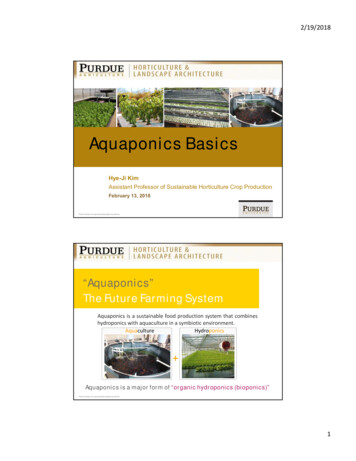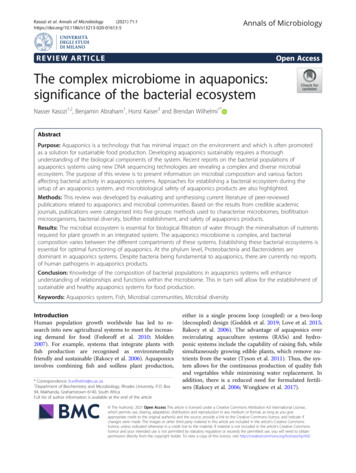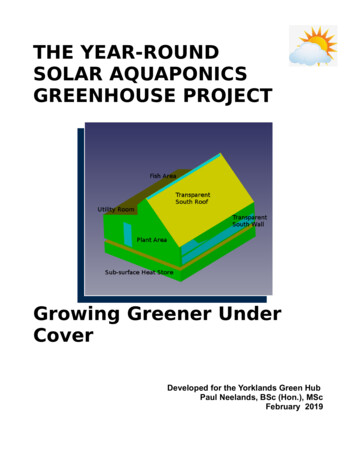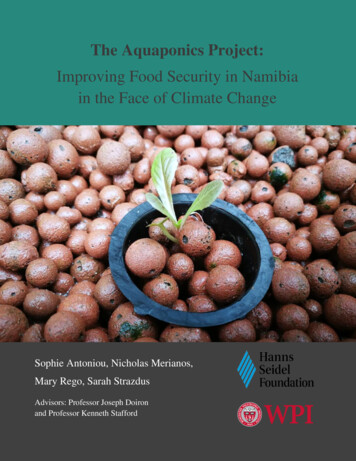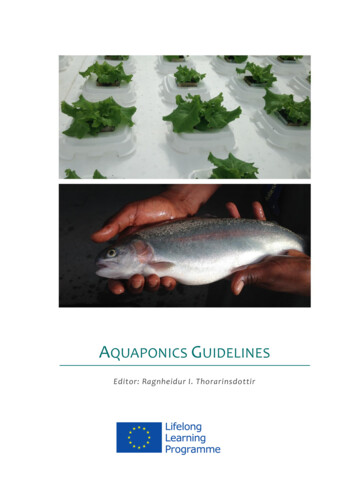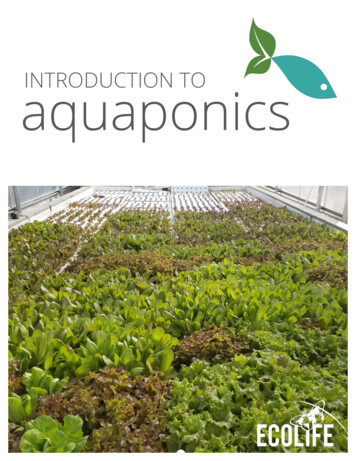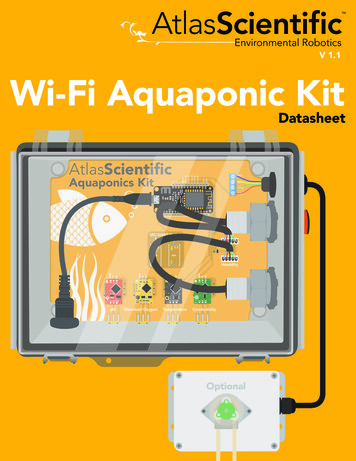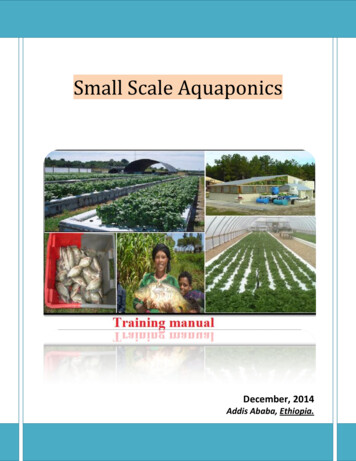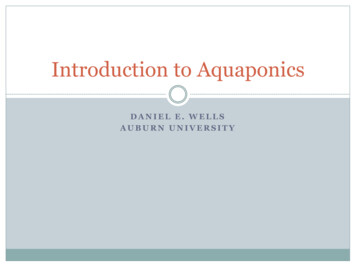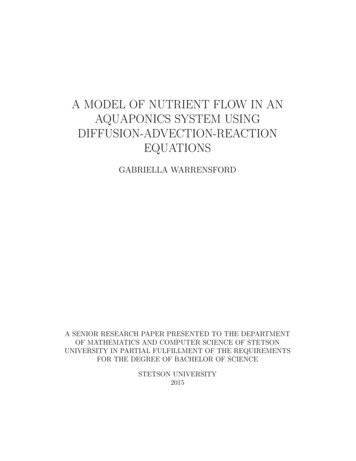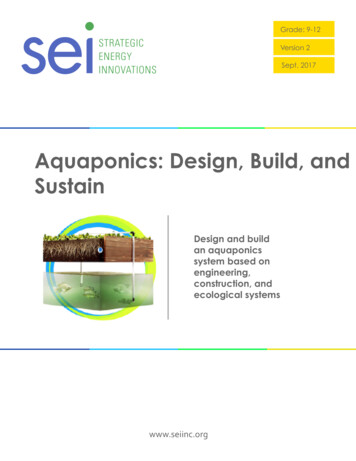
Transcription
Grade: 9-12Version 2Sept. 2017Aquaponics: Design, Build, andSustainDesign and buildan aquaponicssystem based onengineering,construction, andecological systemswww.seiinc.org
Table of ContentsCurriculum Introduction . 3Curriculum Key . 5Setting the Stage . 5Activities . 5Assignments . 5Handouts . 5Extensions . 5Academic Content Standards . 6Materials List . 11Aquaponics Pre & Post-Test. 19Lesson 1: Fundamentals of Aquaponics. 24Key Words . 24Preparation . 24Setting the Stage: An Introduction To Aquaponics . 25Activity 1: The Aquaponics Project . 25Assignment: Researching Aquaponics . 26Setting the Stage: The Benefits of Aquaponics . 26Activity 3: Researching The Benefits & Impacts of Aquaponics . 27Optional: Student Websites . 27Assignment: Research Paper . 28Handout: The Aquaponics Project . 29Handout: Aquaponics Research Project . 30Handout: Creating a Website . 32Lesson 2: Designing & Building The System. 34Key Words . 34Preparation . 35Setting the Stage: Imagining an Aquaponics System . 35Activity 1: Envisioning Your System . 38Assignment . 39Setting the Stage: Technical Considerations . 39Activity 2: Design Pros & Cons . 42Assignment . 45Setting the Stage: Technical Calculations . 45Activity 4: Calculating Pump Load & Carrying Capacity . 46Setting the Stage: Technical Drafting . 46Activity 5: Drafting your Aquaponic System . 47Assignment . 48Setting the Stage: Constructing Your System. 48Handout: Aquaponics System Design . 49Handout: Design Pros & Cons . 52Design Pros & Cons Teacher KEY. 54Handout: Calculating Carrying Capacity & Pump Load . 56Handout: Drafting Your Aquaponics System . 58Handout: Constructing Your System . 60Production and distribution of this document is exclusively limited toStrategic Energy Innovations. www.seiinc.org 20171
Lesson 3: Cultivation and Maintenance . 63Key Words . 63Preparation . 64Setting the Stage: Fish . 64Activity 1: Testing Your Water . 66Aquaponics Check . 67Setting The Stage: The Nitrogen Cycle . 67Activity 2: Testing for the Nitrogen Cycle and pH . 70Assessment . 71Setting the Stage: Plant Cultivation. 72Activity 1: The Life of a Seedling . 73Setting the Stage: Decomposers . 73Setting the Stage: Balanced Ecosystems . 74Activity 2: Online Ecosystem Lab . 74Setting the Stage: System Maintanence . 75System Maintanence: Fish . 75System Maintanence: Plants . 76System Maintanence: Water Quality . 78System Maintanence: Mechanics, Plumbing & Electrical . 79System Maintanence: Documentation . 81Final Options . 81Handout: Nitrogen Cycle and pH Videos Worksheet . 83Nitrogen Cycle and pH Videos Worksheet Teacher KEY . 84Handout: The Life of a Seedling . 85Handout: Online Ecosystem Lab . 87Handout: Adjusting Water Chemistry . 88Handout: LED Aquaponics Lighting . 89LED Aquaponics Lighting Teacher KEY . 91Lesson 4: Water Careers . 92Key Words . 92Preparation . 92Activity 1: Exploring Green Career Pathways . 93Setting the Stage: Exploring Green Career Pathways . 94Setting the Stage: Water Careers . 97Activity 2: Skills Assessment and Job Research . 99Assignments . 100Assessments . 100Setting the Stage: Social Media and Career Development. 100Setting the Stage: Applying for Jobs . 102Activity 3: Resume Writing & Cover Letter . 102Extension . 103Assignments . 104Assessments . 104Handout: Skills Assessment Worksheet . 105Handout: Skills Assessment Matrix . 106Handout: Cover Letter and Resume Writing. 108Handout: Cover Letter Outline . 110Sample Cover Letter for Requesting an Informational Interview . 111Handout: Resume Outline . 112Handout: Sample Resume . 113Production and distribution of this document is exclusively limited toStrategic Energy Innovations. www.seiinc.org 20172
Handout: Career Informational Interview & Shadowing Questions . 114Handout: Career Professional Panel . 115Curriculum IntroductionWelcome to the SEI Aquaponics Curriculum. This curriculum is designed to provide instructors with amenu of project options of various scales for designing, constructing, and maintaining anaquaponics system in your school. The SEI Aquaponics Curriculum is designed with a coredesign/build unit, created to lead students through the initial challenge of designing a sustainableaquaponics system, followed by a suite of independent, cross-disciplinary lessons, so that teachersmay engage students with the system in future classes. The core design/build unit focuses on thepurpose, benefits, design, build, and maintenance of an aquaponics system. The independentlessons are designed to help teachers in a variety of subjects, from culinary arts toentrepreneurship to engineering, utilizing the school aquaponics system as a dynamic learning tool.It is possible to deconstruct the system, rather than maintain it, at the end of the year, to allow thenext cohort of students to experience the design project. However, if you choose to do this, youwill need to consider what you will do with the living organisms in the system after deconstruction.This curriculum package includes:Ø Comprehensive lessons covering the purpose, design, build, and maintenance of aquaponicssystems.Ø Hands-on activities allowing students to explore chemistry, biology, engineering, constructiontrades, and more.Ø Practical applications in research, technical drafting, website development, construction, andfood production through aquaponics.Ø A unit pre- and post-test to assess comprehension and retention of material presented.Administer the test before beginning the unit and upon completion to assess student learningoutcomes.Ø Coverage of Next Generation Science Standards, Common Core ELA and Math Standards,and Career Technical Education StandardsProduction and distribution of this document is exclusively limited toStrategic Energy Innovations. www.seiinc.org 20173
Aquaponics: Design, Build & SustainLesson 1: Fundamentals of AquaponicsLesson 1: Fundamentals ofAquaponicsLesson 1 OverviewEstimated Time5 class periods (225 minutes)Standards CoveredNGSS: HS-LS2-2, HS-ESS3-1, HS-ESS3-4, HSESTI-1, HS-ESTI-3CCSS: Math N-Q, F-LEELA: Reading for Informational Text 7-9,Reading for Literacy in Science and TechnicalSubjects 3, 4, 7, 9CTE: Agricultural & Natural Resources B4.2,B4.3, C2.0-2.4, E1.1, E1.5, E2.6, E6.0, E6.4,G3.4 Energy, Environment & Utilities A6.0Objectives: Students will be able to: Compare and contrast aquaponics totraditional agricultural and fish productionmethods Evaluate and explain the benefits ofaquaponics Demonstrate the nitrogen cyclegraphically Develop a websitePrep Time 2 hours for reviewing the lessons,background information, and assemblingor ordering materialsHandouts 1.1 Aquaponics Project 1.2 Aquaponics Research Project 1.3 Creating a WebsiteAquaponics offers the opportunity to learn abouttechnical design, science, food production, andsustainability. This lesson will introduce students to theconcepts and science behind aquaponics systems, andguide them through research that will allow them toevaluate the benefits of aquaponics.KEY WORDSAquaponics: A method of combining conventionalaquaculture with hydroponics in a recirculating,symbiotic, constructed system (raising fish and plantsin a closed-loop system)Aquaculture: The farming of aquatic organisms suchas fish, crustaceans, mollusks, and aquatic plants; alsoknown as aquafarmingHydroponics: A method of growing plants usingmineral nutrient solutions, in water, without soilScarcity: Short supply of a limited resourcePREPARATIONØ Gather the basic materials needed for theconstruction of the infrastructure of youraquaponics system (see Introduction for materialsordering matrix)§If you are interested in using a smalldesktop system for this project, kit/Materials (for each student/group): 40-100 gal tank/tub 1-2 fish per tank Substrate (rocks, pebbles, or sand)Icon source: CA Dept Fish & Wildlifeaquaculturematters.ca.govProduction and distribution of this document is exclusively limited toStrategic Energy Innovations. www.seiinc.org 201724
Aquaponics: Design, Build & SustainLesson 1: Fundamentals of Aquaponics!Students should have a logbook or journal, which will be their “Aquaponics Log”. Studentswill start this logbook to record data, notes, and observations throughout the project. Studentswill also use it to respond to prompts and answer questions throughout the unit, which willprovide opportunities for participation and assessment of comprehension.Ø Provide each student with access to the internet to explore the FAO Aquaponic ReportØ Print one of the following handouts for each student in the class:§Handout 1.1 The Aquaponics Project§Handout 1.2 Researching Aquaponics§Handout 1.3 Creating a WebsiteSETTING THE STAGE: AN INTRODUCTION TO AQUAPONICSØ Provide each student with The Aquaponics Project Handout. The following lesson will guidestudents through the investigation and research of the rapidly growing discipline ofaquaponics. As students advance in their research, they will evaluate different types ofaquaponics designs, and how aquaponics addresses global issues and human impacts.Ø Aquaponics is the combination of two existing practices for growing food and farming fish:hydroponics and aquaculture. The combination of these two practices creates a recirculating,symbiotic, closed-loop system in which fish waste provides nutrients for plant growth.Ø Hydroponics is a method of growing plants using mineral nutrient solutions, in water, withoutsoil. The plants roots draw nutrients from the mineral rich water itself.Ø Aquaculture is the farming of aquatic organisms such as fish, crustaceans, mollusks, or aquaticplants by cultivating freshwater and saltwater populations under controlled conditions, incontrast to commercial fishing of wild populations.Additional Resources:§For more information on hydroponics, go to: http://www.simplyhydro.com/whatis.htm§For more information on aquaculture, go to:http://www.nmfs.noaa.gov/aquaculture/what is aquaculture.html§For good resources on Aquaponics, visit: 74-0cf4d9874544/i4021e00.htmACTIVITY 1: THE AQUAPONICS PROJECTØ Pass out the Aquaponics Project Handout. Review the handout with the students, explaining thedeliverables and implementation plan for the aquaponics project.Ø After students gain an understanding of the fundamentals of aquaponics as a discipline, theywill draft a blueprint of the aquaponics system they will be setting up in class, and then workwithin a group to construct their very own aquaponics systems.Production and distribution of this document is exclusively limited toStrategic Energy Innovations. www.seiinc.org 201725
Aquaponics: Design, Build & SustainLesson 1: Fundamentals of AquaponicsØ Form groups of 4-5 students that will work together through the duration of the project. Eachstudent will use an Aquaponics Logbook; we suggest creating a digital logbook throughGoogle forms for students to record all activities, water quality data, and observationsrelated to their aquaponics system over the course of the project.§Depending on how many systems you have room for, you may choose to assign eachgroup of students a tank with which to design an aquaponic system, or you may chooseto divide the groups by different roles for one system: engineering & design team, fish& plants team, electronics & pumps team, water quality & maintenance team.!FoodHaveeach group read Chapter 1 and Chapter 2 of the FAO Small-Scale AquaponicProduction Report, and write down 3 questions that they have.Ø Allow a few minutes for the groups to share their questions out to their peers. Students will befinding the answers to their questions through the research project below.ASSIGNMENT: RESEARCHING AQUAPONICSØ Students will take the rest of the week to conduct research at home and/or at school on thefundamentals of how aquaponics works, the different types of designs for aquaponics systems,and the sustainability and benefits of aquaponics. Students will then synthesize their researchinto a 3-5 page research paper. (You may choose to have students give a class presentationin addition to, or in place of, a written paper).Ø Pass out the Researching Aquaponics Handout. Students should use the handout to guide theirresearch and to record their sources of information.Ø Tonight, students should research the first half of the handout, “The How”. They will focus onthe science behind how aquaponics systems function (nutrient cycling, plant requirements,bacteria) and existing aquaponics designs. (Students will research “The Why” after an in-classdiscussion on the benefits of aquaponics.)SETTING THE STAGE: THE BENEFITS OF AQUAPONICSØ The scarcity of resources on the Earth is one of the most important issues that we as humansmust understand and respond to. As our global population grows, we are increasinglyexperiencing the limits of finite resources, from deforestation, droughts and water scarcity, tothe cost and environmental impact of using oil and other fossil fuels. Specifically, ensuringaccess to fresh food and water will continue to be an enormous challenge for human wellbeing. Aquaponics is an innovative solution that addresses the need for sustainable use anddevelopment of our limited resources.Ø One way to look at aquaponics is to consider how it benefits people, our planet, and theeconomy.Ø Optional: Before the brainstorming activity, share the video “Aquaponics Offer HealthySustainable Food” by Grassroots News to get students started on a list of aquaponics benefits.§https://youtu.be/xDgin35wyIc (2:49 mins)Production and distribution of this document is exclusively limited toStrategic Energy Innovations. www.seiinc.org 201726
Aquaponics: Design, Build & SustainLesson 1: Fundamentals of AquaponicsØ Have students pair with a partner and brainstorm for 5-10 minutes to think of two benefits ofaquaponics in each category: people, planet, profit. Students should come up with 1-2sentences on why each is a benefit. After the brainstorm session is over, have the pairs sharetheir answers, create a list of the benefits on the board, and see how many different benefitsthey thought of as a class. After all pairs have shared their ideas, supplement the lists withany benefits they did not mention. Advise each student to copy the benefits in their logbooks.PeoplePlanetProfitHealthy foodUses less waterBusiness opportunitiesCleaner environmentUses less landCreates jobsFeed a growing populationUses less fossil fuelsPlants grow fasterGrow in many areas: urbanareas, roof tops, indoorsNo harmful chemicalsEfficient use of spaceLocal food productionSustainable way to raise fishUtilizes fish wasteCombines fish and producebusiness potentialØ Working with aquaponics develops career skills in a wide variety of disciplines beyondaquaponics farming such as engineering, chemistry, water/wastewater management, andentrepreneurship.Ø Ask students if they can think of other jobs they could find with aquaponics. If students arecreating a website as a part of this project (see below), use it as an example for jobs indigital media, marketing, and graphic design.ACTIVITY 3: RESEARCHING THE BENEFITS & IMPACTS OF AQUAPONICSØ Students will continue their research on aquaponics using the second half of the ResearchingAquaponics Handout, “The Why”. Students should dive more deeply into the benefits andsustainability of aquaponics (e.g. impacts on land use, agriculture, fisheries, local foodproduction, water use).Ø Provide students with access to the library and computers with the Internet.OPTIONAL: STUDENT WEBSITESØ As an optional activity with the Aquaponics Unit, students can create their own webpages thatwill track the progress of their aquaponics system, provide tips and information on successfulaquaponics practices, and may even eventually allow them to start a business selling theirproduce!Ø Pass out the Creating a Website Handout to guide students through the creation of theirwebpage. This leads the students through the use of the website builder Weebly.§An alternative website option is Google sites, which may be preferable if your schoolhas a Google account.Production and distribution of this document is exclusively limited toStrategic Energy Innovations. www.seiinc.org 201727
aquaponics system in your school. The SEI Aquaponics Curriculum is designed with a core design/build unit, created to lead students through the initial challenge of designing a sustainable aquaponics system, followed by a suite of independent, cross-disciplinary lessons, so that teachers may engage stu
